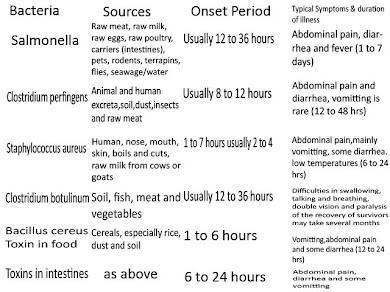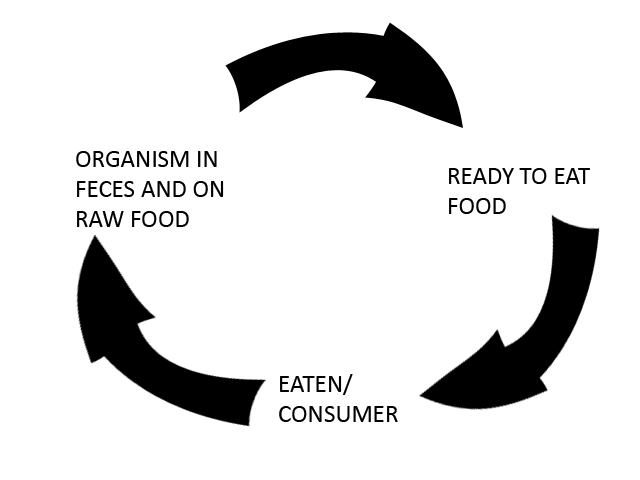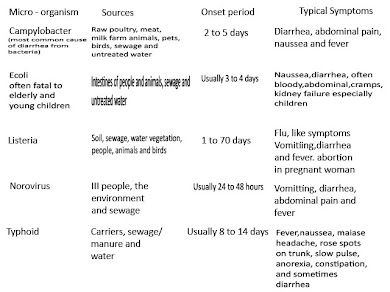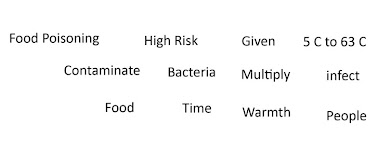HACCP Hazard Analysis Critical Control Points
*it is an operational system and implement effective control measures to ensures the safety of a food produce
*HACCP focuses on the PHF and how the handled PHF are for that have the ability to support rapid
Objective
*safe food it is concerned with the integrity of the food, preparation/processing systems which includes sanitation as part of the system.
*central to food safety very much like the role of the heart in the human body
HACCP History
-Pillsburry company for NASA procedure safe food for astronauts of the apollo space program in 1959, (FMEA) failure mode and effect analysis was adapted to.
HACCP Methodolgy
"farm to fork approach to food safety.
HACCP
*it is a proven system properly applied it will give confidence that the safety of the food. . . . .
Pre Requisite Program
-management support system
-GHP (good hygiene practices)
-sanitation standard operating procedures (SSOP)
3 porpuses
1. protect your products from contamination from microbial chemical and physical hazards.
2. control microbial,chemical and physical hazards.
3. and ensure that procedures for maintaining equipment are in place.
Safety, Hygiene and Sanitation in the Hospitality Operations
Introduction
Food Poisoning is an acme,illness. which usually occurs within one to 36 of eating contaminated food or poisonous food. Symptoms usually last from one to seven days and include one or more of the following: abdominal pain, diarrhea, vomiting, nausea, fever, dehydration and collapse.
The main reasons for food poisoning are negligence, ignorance, poor management and failure to implement good hygiene practices. Food poisoning can be prevented by developing a food safety culture in all food business, this involve effective supervision and the instruction and training of the food handlers by knowledgeable manager.
The main reasons for food poisoning are negligence, ignorance, poor management and failure to implement good hygiene practices. Food poisoning can be prevented by developing a food safety culture in all food business, this involve effective supervision and the instruction and training of the food handlers by knowledgeable manager.
The Ten Factors contributing to food poisoning outbreaks.
1. Food prepared too far slowly prior to refrigeration.
2. Cooling food too slowly prior to refrigeration.(improper cooling).
3. Not reheating food to high enough temperature to destroy food poisoning bacteria. (improper cooking).
4. The use of cooked food contaminated with food poisoning bacteria.
5. Under cooking
6. Not thawing frozen
7. Not thawing frozen food for sufficient time. (improper thawing).
8. The consumption of raw food such as shellfish, eggs or milk. (unknown source of seafood).
9. Storing not food below 63 centigrade.
10. Infected food handlers.
what the law Says:
food handlers must be supervised and instructed and/or trained in food hygiene matters commensurate their work activity.
2. Cooling food too slowly prior to refrigeration.(improper cooling).
3. Not reheating food to high enough temperature to destroy food poisoning bacteria. (improper cooking).
4. The use of cooked food contaminated with food poisoning bacteria.
5. Under cooking
6. Not thawing frozen
7. Not thawing frozen food for sufficient time. (improper thawing).
8. The consumption of raw food such as shellfish, eggs or milk. (unknown source of seafood).
9. Storing not food below 63 centigrade.
10. Infected food handlers.
what the law Says:
food handlers must be supervised and instructed and/or trained in food hygiene matters commensurate their work activity.
hazards.
Food handlers must be aware of the specific hazards associated with their activities and how there hazards can be controlled. A hazard is the potential to cause harm to the consumer and the main hazards are:
- microbiological such as, viruses, moulds and parasites
- physical such as glass, screws, drawing pins and stones
- chemical such as insecticides and cleaning chemicals
- allergenic such as peanuts and sesame seeds
Understanding food Hygiene and Safety:
Food hygiene is more than cleanliness; it includes all practices involved in:
- Protecting food from risk of contamination, including harmful bacteria, poisons and foreign bodies.
- Preventing any bacteria present multiplying to an extent which would result in the illness of consumers or the early spoilage of the food.
- Destroying any harmful bacteria in the food through cooking or processing.
- Discarding unfit or contaminated food.
The cost of food Hygiene safety:
(what are the cost of poor hygiene in an establishment?)
- food poisoning outbreaks and sometimes death.
- food contamination and customer complaints.
- brain damage.
- pest infestation.
- waste food due to spoilage.
- the closure of food premises by local authority.
- fines and cost of legal action taken because of contraventions in hygiene legislation or because of the sale of unfit or unsatisfactory food.
- Civil action taken by food poisoning sufferers.
The benefits of good food hygiene/safety:
(what are the good benefits of good hygiene?)
- Satisfied customers, a good reputation, increased business and brand protection.
- Compliance with food safety regulation.
- Less food wastage's and increased shelf-life of food.
- Good working condition, higher staff morale and lower staff turnover, which promote increased productivity.
- microbiological such as, viruses, moulds and parasites
- physical such as glass, screws, drawing pins and stones
- chemical such as insecticides and cleaning chemicals
- allergenic such as peanuts and sesame seeds
Understanding food Hygiene and Safety:
Food hygiene is more than cleanliness; it includes all practices involved in:
- Protecting food from risk of contamination, including harmful bacteria, poisons and foreign bodies.
- Preventing any bacteria present multiplying to an extent which would result in the illness of consumers or the early spoilage of the food.
- Destroying any harmful bacteria in the food through cooking or processing.
- Discarding unfit or contaminated food.
The cost of food Hygiene safety:
(what are the cost of poor hygiene in an establishment?)
- food poisoning outbreaks and sometimes death.
- food contamination and customer complaints.
- brain damage.
- pest infestation.
- waste food due to spoilage.
- the closure of food premises by local authority.
- fines and cost of legal action taken because of contraventions in hygiene legislation or because of the sale of unfit or unsatisfactory food.
- Civil action taken by food poisoning sufferers.
The benefits of good food hygiene/safety:
(what are the good benefits of good hygiene?)
- Satisfied customers, a good reputation, increased business and brand protection.
- Compliance with food safety regulation.
- Less food wastage's and increased shelf-life of food.
- Good working condition, higher staff morale and lower staff turnover, which promote increased productivity.
B. sanitation
MICROBIOLOGICAL HAZARDS:
Microbiological hazards include:
- the contamination of food by bacteria, viruses, moulds and parasites.
- the multiplication of bacteria within food.
- the survival of bacteria or other pathogens because of inadequate cooking or processing.
Microbiological hazards include:
- the contamination of food by bacteria, viruses, moulds and parasites.
- the multiplication of bacteria within food.
- the survival of bacteria or other pathogens because of inadequate cooking or processing.
Bacteria
Bacteria are microscopic organism, often referred to as germs, which are found everywhere including on and in people, on food, in water, soil and air, other bacteria known as spoilage bacteria cause food to perish, spoil or become unfit. Food poisoning bacteria are known as pathogens.
Requirements for bacterial multiplication
Bacteria responsible for causing food poisoning need the following conditions to enable them to multiply and in some cause produce toxins.
- Warmth
- Food and moisture.
- High risk food
a. cooked meat and cooked poultry
b. cooked meat products including pates, gravy, stews, meat pies, spreads, and stock.
c. milk cream, artificial cream, soft cheese, custards and dairy product.
d. egg and products made from raw eggs, mayonnaise, mousses.
e. shellfish and other seafood especially oysters, prawns and crabs.
f. cooked rice.
- low risk food
- Ready to eat foods
- Time
Requirements for bacterial multiplication
Bacteria responsible for causing food poisoning need the following conditions to enable them to multiply and in some cause produce toxins.
- Warmth
- Food and moisture.
- High risk food
a. cooked meat and cooked poultry
b. cooked meat products including pates, gravy, stews, meat pies, spreads, and stock.
c. milk cream, artificial cream, soft cheese, custards and dairy product.
d. egg and products made from raw eggs, mayonnaise, mousses.
e. shellfish and other seafood especially oysters, prawns and crabs.
f. cooked rice.
- low risk food
- Ready to eat foods
- Time
food poisoning and control
Food Poisoning may be caused by:
- bacteria or their toxins.
- viruses.
- moulds
- chemical such as insecticides, cleaning agents and weedkillers
- metals such as lead, copper and mercury.
- poisonous plant
- poisonous fish or shellfish.
- bacteria or their toxins.
- viruses.
- moulds
- chemical such as insecticides, cleaning agents and weedkillers
- metals such as lead, copper and mercury.
- poisonous plant
- poisonous fish or shellfish.
IMPORTANT FOOD POISONING BACTERIA

foodborne diseases/illness
In addition to food poisoning other illness can result from eating food water which carries harmful micro organism.
THE FAECAL - ORAL ROUTE

FOODBORNE DISEASES

THE control of food poisoning
Food poisoning rarely occurs because of single isolated mistake. Food poisoning results from management failing to identify the hazards and/or failing to control these hazards. The food poisoning chain consist of three major hazards
- the contamination of high risk food
- the multiplication of bacteria within the food
- the survival of bacteria within the food
Controlling these hazards breaks the chain and prevents food poisoning.
- the contamination of high risk food
- the multiplication of bacteria within the food
- the survival of bacteria within the food
Controlling these hazards breaks the chain and prevents food poisoning.
The Food poisoning Chain

protect food from contamination by:
- purchasing food from approved suppliers
- effective instruction, supervision and training of food handlers
- high standards of personal hygiene and good hygiene practices and the provision of adequate, suitable facilities for securing personal hygiene.
- well designed and constructed food premises and food rooms
- effective pest control
- the separation of raw and high risk food at all stages of delivery, storage, preparation, serving and distribution. particular care needed when thawing raw poultry and cooling cooked meat.
- effective storage and disposal of waste and unfit food.
- well designed and proper used of suitable equipments/utensils.
- effective cleaning and disinfection. particular care is needed with wiping clothes
- effective instruction, supervision and training of food handlers
- high standards of personal hygiene and good hygiene practices and the provision of adequate, suitable facilities for securing personal hygiene.
- well designed and constructed food premises and food rooms
- effective pest control
- the separation of raw and high risk food at all stages of delivery, storage, preparation, serving and distribution. particular care needed when thawing raw poultry and cooling cooked meat.
- effective storage and disposal of waste and unfit food.
- well designed and proper used of suitable equipments/utensils.
- effective cleaning and disinfection. particular care is needed with wiping clothes
prevent bacteria within food from multiplying by:
- storing food out of danger zone
- ensuring that during food preparation, food is within the danger zone for a short time as possible.
- cooling food as rapidly as possible
- not allowing dried foods to absorb moisture
- using suitable preservative such as salt, sugar, or vinegar/acid.
- fermentation.
- ensuring that during food preparation, food is within the danger zone for a short time as possible.
- cooling food as rapidly as possible
- not allowing dried foods to absorb moisture
- using suitable preservative such as salt, sugar, or vinegar/acid.
- fermentation.
destroy those bacteria within food by:
- thorough cooking.
- heat processing such as pasteurization, sterilization or canning
- irradiation
- using chemical
- heat processing such as pasteurization, sterilization or canning
- irradiation
- using chemical
food handlers and personal hygiene:
food handlers are potentially the most serious hazard in a food business. bad practices of food handlers may result in the contamination of high risk food with poisoning organisms or foreign body hazards.
HANDS AND SKIN:
As the hands are in direct contact with food, they are the most common vehicle for transferring food poisoning bacteria. Hands may be keep clean at all times, the correct hand washing procedure is essential to prevent contaminating food. Food handlers must wash their hands regularly throughout the working day and especially:
- after visiting the toilet.
- on entering the food room, after a break and before handling any food.
- after putting or changing a dressing.
- after handling raw food, including eggs and before handling ready to eat food.
- after cleaning up animal feces or handling boxes or waste contaminated by bird droppings.
- after combing or touching the hair,face,nose,mouth and ears.
- after handling waste food or refuse.
- after cleaning or handling dirty clothes, crockery etc.
- after handling external packaging, flowers or money.
what the law says:
wash basins must be provided with hot and cold water, soap and drying facilities.
NOSE, MOUTH AND EARS:
Up to 40% of adults carry staphylococci in the nose and mouth. Cough and sneezes can carry droplet infection for a considerable distance and persons with bad colds should not handle open food. as the mouth likely to harbor staphylococci food handlers should not eat sweets, chew gums, taste food with finger or an unwashed spoon or blow into glasses to polish them. apart from being aesthetically unacceptable, spitting can obviously result in food contamination and is illegal.
CUTS, BOILS, WHIT LOWS AND SEPTIC SPOTS.
Cuts, spots and sores provide an ideal place for bacterial multiplication. To prevent contamination of food by harmful bacteria and blood. Theses lesions should be completely covered by waterproof dressing.
JEWELRY AND PERFUME:
Food handlers should not wear earrings, watches, jeweled rings or brooches as they harbor dirt and bacteria. Food handlers should not apply strong perfume or aftershave.
THE HAIR:
Hair is constrain out along with dandruff can result in contamination food.
SMOKING:
Smoking is not allowed in food rooms or whilst handling open food as it results in microbiological contamination and physical contamination. It also encourage coughing and droplet infection and creates an unpleasant environment.
PROTECTIVE CLOTHING:
Food handlers must wear clean and washable over clothing. Staff must be aware that protective clothing is worn to protect food from risk of contamination and not to keep their own clothes clean. Outdoor clothing and personal effects must not be brought into food rooms unless stored in suitable lockers. Protective clothing should not be hung in sanitary accommodation.
GENERAL HEALTH AND REPORTING ILLNESS
Food handlers should be in good health in all aspects from oral hygiene to general fitness. Any food handlers suffering from diarrhea, vomiting or food borne illness must not handle food.
CARRIERS:
Carriers are people who may excrete pathogenic organisms showing of illness.
HYGIENE TRAINING:
all food handlers must be aware of the hygiene hazards associated with their jobs and the controls necessary to ensure the safety of food produced. A Training programme should be implemented to ensure the competency of all food handlers to produce safe food.
What the Law says:
- food handlers to have high standards of personal cleanliness wear suitable protective clothing
- food handlers with foodborne disease or with infected wound, skin infections or diarrhea must not handle food and must report to supervisor any symptoms or illness.
- food handlers must be supervised and instructed and or trained in food hygiene matter.
YOUR RESPONSIBILITY:
- to keep yourself, your protective clothing and your hands clean
- to cover cuts with waterproof blue plasters
- to report food poisoning symptoms or skin infections to your supervisor before handling food.
- to successfully complete and implement your hygiene training
- to report from your supervisor if there are no soap, hot water or drying facility.
HANDS AND SKIN:
As the hands are in direct contact with food, they are the most common vehicle for transferring food poisoning bacteria. Hands may be keep clean at all times, the correct hand washing procedure is essential to prevent contaminating food. Food handlers must wash their hands regularly throughout the working day and especially:
- after visiting the toilet.
- on entering the food room, after a break and before handling any food.
- after putting or changing a dressing.
- after handling raw food, including eggs and before handling ready to eat food.
- after cleaning up animal feces or handling boxes or waste contaminated by bird droppings.
- after combing or touching the hair,face,nose,mouth and ears.
- after handling waste food or refuse.
- after cleaning or handling dirty clothes, crockery etc.
- after handling external packaging, flowers or money.
what the law says:
wash basins must be provided with hot and cold water, soap and drying facilities.
NOSE, MOUTH AND EARS:
Up to 40% of adults carry staphylococci in the nose and mouth. Cough and sneezes can carry droplet infection for a considerable distance and persons with bad colds should not handle open food. as the mouth likely to harbor staphylococci food handlers should not eat sweets, chew gums, taste food with finger or an unwashed spoon or blow into glasses to polish them. apart from being aesthetically unacceptable, spitting can obviously result in food contamination and is illegal.
CUTS, BOILS, WHIT LOWS AND SEPTIC SPOTS.
Cuts, spots and sores provide an ideal place for bacterial multiplication. To prevent contamination of food by harmful bacteria and blood. Theses lesions should be completely covered by waterproof dressing.
JEWELRY AND PERFUME:
Food handlers should not wear earrings, watches, jeweled rings or brooches as they harbor dirt and bacteria. Food handlers should not apply strong perfume or aftershave.
THE HAIR:
Hair is constrain out along with dandruff can result in contamination food.
SMOKING:
Smoking is not allowed in food rooms or whilst handling open food as it results in microbiological contamination and physical contamination. It also encourage coughing and droplet infection and creates an unpleasant environment.
PROTECTIVE CLOTHING:
Food handlers must wear clean and washable over clothing. Staff must be aware that protective clothing is worn to protect food from risk of contamination and not to keep their own clothes clean. Outdoor clothing and personal effects must not be brought into food rooms unless stored in suitable lockers. Protective clothing should not be hung in sanitary accommodation.
GENERAL HEALTH AND REPORTING ILLNESS
Food handlers should be in good health in all aspects from oral hygiene to general fitness. Any food handlers suffering from diarrhea, vomiting or food borne illness must not handle food.
CARRIERS:
Carriers are people who may excrete pathogenic organisms showing of illness.
HYGIENE TRAINING:
all food handlers must be aware of the hygiene hazards associated with their jobs and the controls necessary to ensure the safety of food produced. A Training programme should be implemented to ensure the competency of all food handlers to produce safe food.
What the Law says:
- food handlers to have high standards of personal cleanliness wear suitable protective clothing
- food handlers with foodborne disease or with infected wound, skin infections or diarrhea must not handle food and must report to supervisor any symptoms or illness.
- food handlers must be supervised and instructed and or trained in food hygiene matter.
YOUR RESPONSIBILITY:
- to keep yourself, your protective clothing and your hands clean
- to cover cuts with waterproof blue plasters
- to report food poisoning symptoms or skin infections to your supervisor before handling food.
- to successfully complete and implement your hygiene training
- to report from your supervisor if there are no soap, hot water or drying facility.
danger zone

CGMP means?
C.G.M.P
current good manufacturing/management practices
four elements of CGMP
1. HYGIENE - proper hand washing, using hairnets, awareness of open wounds.
2. SAFETY - no jewelries, wearing of gloves.
3. APPEARANCE - proper uniform & proper shoes
4. COMMON SENSE - no eating, no smoking, no eating of chewing gum in the area.
current good manufacturing/management practices
four elements of CGMP
1. HYGIENE - proper hand washing, using hairnets, awareness of open wounds.
2. SAFETY - no jewelries, wearing of gloves.
3. APPEARANCE - proper uniform & proper shoes
4. COMMON SENSE - no eating, no smoking, no eating of chewing gum in the area.
personal hygiene
1. train food service employees on the employee health policy (develop SOP for implementing on employee health policy). and on practicing good personal hygiene.
2. follow the employee health policy
3. report to work in good health, clean & dressed in clean attire.
4. changed aprons hen it becomes soiled.
5. wash hands properly, frequently, and at appropriate time.
6. keep finger nails trimmed, filled and maintains so that the edges are cleanable and are not enough.
7. avoid wearing artificial fingernails or fingernail polish.
8.wear sample gloves if artificial fingernails or finger nail polish are worn.
9. do not wear any jewelry,no wrist watches.
10. treat & bandage wounds and scars immediately, hen hands are bandaged singled gloves must be worn.
11. causes a lesion containing pus with a bandage. if the lesion is on a hand wrist, cover with an imperceptible cover such as finger cot or stall and single use gloves
12. eat, drink, smoke or chew gum only in designated break areas where food or food contact surfaces may not become contaminated.
13. taste food the correct way
- place small amount of food into separate containers.
- step away from exposed food & food contact surfaces
- use a teaspoon to taste the food, remove the used teaspoon and container to the dish room. never reuse a spoon that has already been used for tasting.
- wash hands immediately.
14. wear suitable and effective hair restrains while in the kitchen.
15. follow public health requirements.
2. follow the employee health policy
3. report to work in good health, clean & dressed in clean attire.
4. changed aprons hen it becomes soiled.
5. wash hands properly, frequently, and at appropriate time.
6. keep finger nails trimmed, filled and maintains so that the edges are cleanable and are not enough.
7. avoid wearing artificial fingernails or fingernail polish.
8.wear sample gloves if artificial fingernails or finger nail polish are worn.
9. do not wear any jewelry,no wrist watches.
10. treat & bandage wounds and scars immediately, hen hands are bandaged singled gloves must be worn.
11. causes a lesion containing pus with a bandage. if the lesion is on a hand wrist, cover with an imperceptible cover such as finger cot or stall and single use gloves
12. eat, drink, smoke or chew gum only in designated break areas where food or food contact surfaces may not become contaminated.
13. taste food the correct way
- place small amount of food into separate containers.
- step away from exposed food & food contact surfaces
- use a teaspoon to taste the food, remove the used teaspoon and container to the dish room. never reuse a spoon that has already been used for tasting.
- wash hands immediately.
14. wear suitable and effective hair restrains while in the kitchen.
15. follow public health requirements.
Proper hand Washing

Martes, Agosto 3, 2010
hand washing steps
1.) wet hands
2.) soap (20 seconds)
3.) scrub backs of hands,wrists,between fingers under fingernails.
4.) rinse
5.) towel dry
6.) turn off taps with towel
when do you wash your hands?
-after visiting the toilet
-on entering the food room,after a break and before handling foods.
2.) soap (20 seconds)
3.) scrub backs of hands,wrists,between fingers under fingernails.
4.) rinse
5.) towel dry
6.) turn off taps with towel
when do you wash your hands?
-after visiting the toilet
-on entering the food room,after a break and before handling foods.
Linggo, Hulyo 25, 2010
Mag-subscribe sa:
Mga Komento (Atom)